[Retracted] Eccentricity-Based Topological Descriptors of First Type of Hex-Derived Network
Abstract
Graph theory has made significant progress in mathematical chemistry and has gained a lot of traction among scientists due to its numerous applications in mathematical chemistry. The numerical invariants of a molecular structure are known as molecular topological descriptors, and they are highly effective for predicting their bioactivity. A number of such indices are examined and applied in pharmaceutical research, chemistry, medication development, and other fields. The eccentricity-based Zagreb indices, total eccentricity, geometric arithmetic (GA4), atom-bond connectivity (ABC5), and average eccentricity indices of a hex-derived network of first type are computed in this article. We also provide analytically closed formulas for these descriptors, which may be used to investigate the underlying topologies.
1. Introduction
Graph theory is a vital organ of scientific tools to study the mechanism of different molecular structures and networks without going into the labor of laboratory work. It provides valid reasons to adopt the techniques of topological indices to cater for the difficult molecular structures which might not be studied by any other technique. It has several applications in social sciences, computer science, neural network, genomics, molecular biology, and chemistry. Chemical graph theory is a hot topic among researchers and allows us to estimate some physicochemical features of chemical substances just by looking at their visual representations [1, 2]. A molecular frame can be described by covalent bonds which connects the atoms. In case of graph theory, atoms are vertices and these covalent bonds are edges between atoms. Information sciences, mathematics, and chemistry are combined in cheminformatics. This is a new research field that attracts the attention of researchers. Chemical graph theory is a branch of chemistry that uses graph theory to represent chemical substances mathematically. There has been a lot of study on this topic during the last few decades. The importance of graph theory in chemistry is demonstrated by few references [3, 4].
Consider a graph G = (V, E), where V and E are nonempty sets of vertices and edges. Chemical graph theory uses graph theory to model molecular phenomena mathematically, which is useful for studying molecular structures. Pharmaceutical researchers study and apply a wide range of TI’s in theoretical chemistry. There are several TI’s for graph in chemical graph theory that are useful in the study of chemical compounds. This approach has had a significant impact on chemical science advancement.
d(i, j) is distance between i and j and can be defined as the length of shortest path in G if i, j ∈ V(G). Eccentricity is distance between vertex i and the farthest vertex in the graph.
where is the eccentricity of the vertex s.
Many researchers like Hinz, Ilic, Dankelmann, and Tang have worked on average eccentricity index, demonstrated by few references [6–9].
Imran et al. computed ABC5 and GA4 indices of copper oxide in [13], and Gao et al. [14] shows the results of linear polycene parallelogram benzenoid.
2. Applications and Motivation
Because degree-based TI’s are beneficial for analyzing the chemical properties of various molecule structures. As a result of this inspiration, we concentrate on eccentricity-based TI’s. Topological index based on eccentricity is a useful method to predict physicochemical and toxicological properties of a substance [17–19]. Recent activity on hex-derived networks can be studied in [20–22].
Zobair et al. studied TI’s of carbon nanocones as well as TI’s of different families of David-derived networks in [23, 24]. One index, known as the ABC index, has extremely good results for determining the stability and strain energy of hydrocarbons. [25–28]. The GA index has much stronger prediction potential than the Randic connectivity index [29–31]. Within specified approximate formulas, the Zagreb indices used for computation of total Π-electron energy of the molecules [32].
3. Hex-Derived Network
Hexagonal structures had observed a lot of applications in different fields including chemical engineering, transportation, mechanical engineering, architecture, nanofabrication, and recently bioinformatics. The greatest challenge in this research direction is to comprehend the unique characteristics of hex-derived structures, relying on their structures, scales, and the materials used to allow the minimization of the materials to get minimum weight and maximum strength. Hex-derived networks are under consideration in the present research article which are further extracted from hexagonal structures. Figure 1(a)shows a hex-derived network for two dimension, Figure 1(c) demonstrates thatHX(2)has faces, and Figure 2 shows an example of HDN1(3) [33].
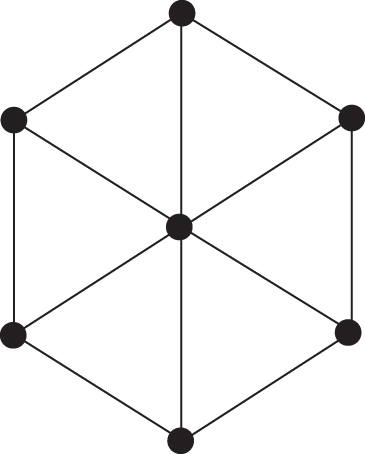
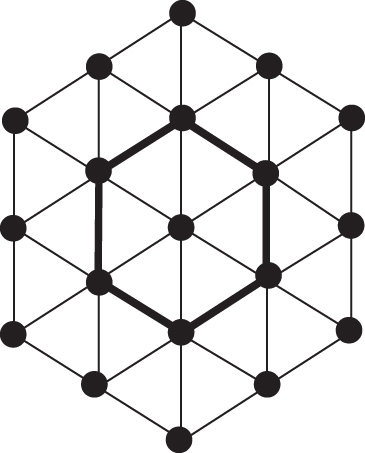
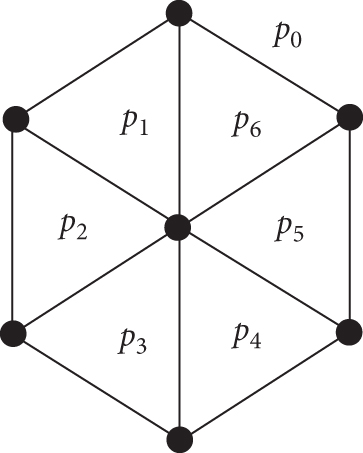
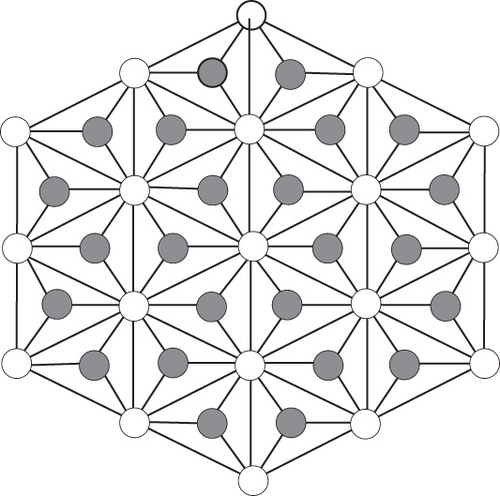
- (i)
For major findings, based on eccentricity, we divide the vertices of the HDN1(n) into two sets. The eccentricity of the set V1 is , and the number of vertices in the set is 1, β = 1, and n ≥ 2. The set V2 contains the vertices with the eccentricity , and the number of vertices in the set V2 is 6(3β − 4), 2 ≤ β ≤ n, n ≥ 2. In addition, the variable β denotes the distance between two vertices, which assists in the creation of this vertex division. Additionally, β denotes the range of the total number of vertices having that eccentricity. Table 1 shows the vertex division of a HDN1 depending on the eccentricity of each vertex.
- (ii)
Now, we divide the edges of the HDN1(n) based on the eccentricity into two sets of the end vertices. The set E1 contains edges with eccentricities , 2 ≤ β ≤ n, n ≥ 2, and E1 set is (30m − 18), 1 ≤ m ≤ n − 1. The set E2 contains the edges with eccentricities , 2 ≤ β ≤ n, n ≥ 2, and E2 set is (24m − 6), 1 ≤ m ≤ n − 1. In addition, β denotes the total number of pairing with that eccentricities. Table 2 shows the edge division of a HDN1(n) Â depending on the eccentricity of end vertices.
| Sets | Number of vertices | Range of β and n | |
|---|---|---|---|
| V1 | n − 1 | 1 | β = 1, n ≥ 2 |
| V2 | n + β − 2 | 6(3β − 4) | 2 ≤ β ≤ n, n ≥ 2 |
| Sets | Edge frequency | β value range | Range of m and n | |
|---|---|---|---|---|
| E1 | (n + β − 3, n + β − 2 | 30m − 18 | 2 ≤ β ≤ n | 1 ≤ m ≤ n − 1 |
| E2 | n + β − 2, n + β − 2 | 24m − 6 | 2 ≤ β ≤ n | 1 ≤ m ≤ n − 1 |
3.1. Main Results for HDN1(n)
The close approximations of some TI’s for this network were calculated in this section. We have founnd here the closed results for total eccentricity, average eccentricity, eccentricity version of Zagreb, eccentric ABC, and GA indices for hex-derived networks of first type.
Theorem 3.1.1. Consider HDN1(n), ∀n ∈ N, n ≥ 2, be the graph of first type of hex-derived network, then ζ index of HDN1(n) is
Proof. Consider HDN1(n), ∀n ∈ N, n ≥ 2, be the first type Hex-derived network.
We calculated the total eccentricity index as follows, using the vertices partitioned from Table 1 and Equation (2):
Theorem 3.1.2. Consider HDN1(n), ∀n ∈ N, n ≥ 2, be the graph of first type of hex-derived network, then the avec index of HDN1(n) is
Proof. Consider HDN1(n), ∀n ∈ N and n ≥ 2 containing 9n2 − 15n + 7 vertices and 27n2 − 51n + 24 edges.
We calculated the average eccentricity index as follows, using the vertices partitioned from Table 1 and Equation (3):
Theorem 3.1.3. Consider HDN1(n), ∀n ∈ N, n ≥ 2, be the graph of first type of hex-derived network, then of HDN1(n) is
Proof. Consider HDN1(n), ∀n ∈ N and n ≥ 2. We calculated as follows, using Table 2 edge partitioning and Equation (6):
Theorem 3.1.4. Consider HDN1(n), ∀n ∈ N, n ≥ 2, be the graph of first type of hex-derived network, then index of HDN1(n) is
Proof. Consider HDN1(n), ∀n ∈ N, n ≥ 2, be the hex-derived network of first type. We calculated the second Zagreb eccentricity index as follows, using the vertices partitioned from Table 1 and Equation (7); the proof is analogue of Theorem 3.1.3.
Theorem 3.1.5. Consider HDN1(n), ∀n ∈ N, n ≥ 2, be the graph of first type of hex-derived network, then the index of HDN1(n) is
Proof. Consider HDN1(n), ∀n ∈ N, n ≥ 2, be the hex-derived network of first type.
We calculated the third Zagreb eccentricity index as follows, using Table 2 edge partitioning and Equation (8):
Theorem 3.1.6. Consider HDN1(n), ∀n ∈ N, n ≥ 2, be the graph of first type of hex-derived network, then the GA4 index of HDN1(n) is
Proof. Consider HDN1(n), ∀n ∈ N, n ≥ 2, be the hex-derived network of first type.
We calculated the eccentric GA4 index as follows, using Table 2 edge partitioning and Equation (4):
Theorem 3.1.7. Consider HDN1(n), ∀n ∈ N, n ≥ 2, be the graph of first type of hex-derived network, then the ABC5 index of HDN1(n) is
4. Comparison and Discussion
The eccentricity-based TI’s of the HDN1(n) first type of hex-derived network for specific values of m and β are compared in Figures 3–5. It is obvious from the graphs that the values of indices are increasing for different m and β. So that it provides an indication that the results provided for different indices are true.
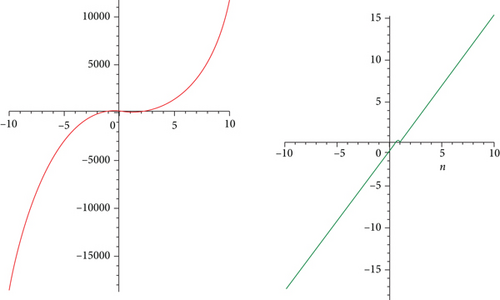
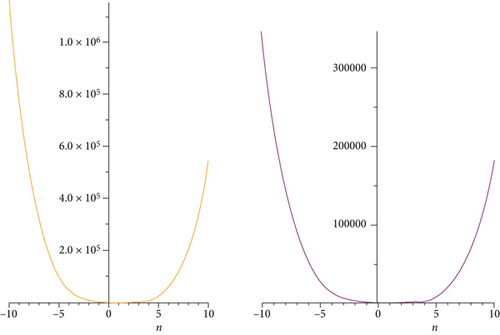
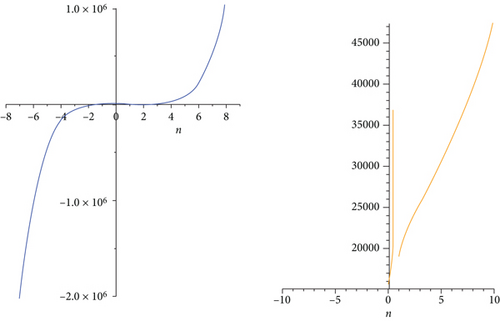
5. Conclusion
In this article, eccentricity-based TI’s, the average eccentricity, eccentric version of Zagreb indices, total eccentricity index, eccentricity version of geometric-artithmatic index, and atom-bond connectivity index based on eccentricity for first type of hex-derived network are contemplated and investigate the basic topologies of these networks. Furthermore, we made a comparison in Figures 3–5 by the use of graph comparison. This analysis will facilitate researchers engaged in network science in recognizing the topology of the abovementioned networks. Furthermore, the results presented in this paper might be helpful in the QSPR/QSAR analysis to predict further structural and physicochemical properties of molecular graphs under discussion.
Conflicts of Interest
There is no conflict of interest among the authors.
Open Research
Data Availability
The data used to support the findings of this study are included within the article.




